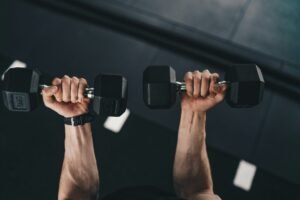We all want to be strong, lean, and healthy, but sometimes it can feel overwhelming to know where to start. With so much conflicting information out there, it’s easy to feel lost and unsure. But fear not, because this ultimate guide has got you covered. Whether you’re a seasoned fitness enthusiast or just starting out, this guide will provide you with everything you need to build a stronger, leaner, and healthier body. From nutrition and exercise to mindset and recovery, we’ll cover all the bases and give you actionable steps you can take to achieve your goals. So grab a pen and paper and get ready to transform your body and your life.
1. Understanding the importance of a healthy body
Understanding the importance of a healthy body is the foundation to building a stronger, leaner, and healthier body. A healthy body is not only about having a good physique but also about having a strong immune system, a healthy heart, and being mentally and emotionally fit.
When we have a healthy body, we are able to perform better in our daily activities, have more energy, and have a more positive outlook on life. Additionally, a healthy body can help prevent chronic diseases such as heart disease, diabetes, and cancer.
Moreover, a healthy body can also improve our mental health, reduce stress, and increase our confidence. When we take care of our body, we feel good about ourselves and this reflects in our relationships and interactions with others.
Therefore, it’s important to prioritize our health and well-being by making healthy choices such as eating a balanced diet, exercising regularly, getting enough sleep, managing stress, and avoiding harmful habits like smoking and excessive alcohol consumption. By doing so, we can achieve a healthy body that will enable us to live our best life.
2. Assessing Your Fitness Level

Image: unsplash
Before starting any exercise routine or embarking on a journey towards a stronger, leaner, and healthier body, it is important to assess your current fitness level. This will help you determine where you stand, what your strengths and weaknesses are, and where you need to focus your efforts to achieve your fitness goals.
The first step in assessing your fitness level is to determine your body composition. This can be done in a number of ways, such as measuring your body fat percentage or using a body composition analyzer. Knowing your body composition will give you a clear understanding of how much muscle and fat you have, and where you need to focus your efforts to achieve a leaner body.
The next step is to assess your cardiovascular fitness by performing a simple test such as the 1-mile walk or jog test. This test will help you determine your cardiovascular endurance and give you a starting point for developing a cardio routine.
Strength is another important aspect of fitness, and assessing your strength level is crucial for building a stronger body. You can perform basic strength tests such as push-ups, pull-ups, squats, and lunges to assess your strength level and determine where you need to focus your efforts to improve.
Finally, flexibility is a key component of fitness that is often overlooked. Assessing your flexibility level will help you determine if you need to incorporate more stretching and mobility exercises into your routine to ensure your body stays healthy and injury-free.
By assessing your fitness level before starting any exercise routine, you can develop a personalized plan that will help you achieve your goals more effectively and efficiently.
3. Setting realistic fitness goals
When it comes to building a stronger, leaner, and healthier body, setting realistic fitness goals is crucial. Many people have a tendency to set lofty goals, such as losing 20 pounds in a month or running a marathon within six months, which can ultimately lead to disappointment and discouragement.
Instead, break down your long-term goals into smaller, more achievable milestones. For example, aim to lose a pound a week or to run a 5k within three months. Celebrate each milestone along the way, as this will help you stay motivated and on track.
It’s also important to make sure your fitness goals are realistic for your lifestyle and fitness level. If you’re just starting out, it may not be realistic to work out six days a week for an hour each day. Instead, aim for two to three days a week and gradually increase your workout frequency and duration as your fitness level improves.
Remember, building a stronger, leaner, and healthier body is a journey, not a destination. Focus on progress, not perfection, and be kind to yourself along the way. With realistic fitness goals and a positive mindset, you’ll be well on your way to achieving the body you desire.
4. Creating a workout plan that suits you
Creating a workout plan that suits you can be the difference between success and failure when it comes to your fitness goals. It’s important to find a workout plan that is tailored to your fitness level, goals, and lifestyle.
First, consider your current fitness level. Are you a beginner or have you been working out for a while? If you’re a beginner, it’s important to start with light to moderate exercises and gradually increase the intensity and duration over time.
Next, determine your fitness goals. Do you want to lose weight, gain muscle, or improve your overall fitness level? Depending on your goals, your workout plan may include strength training, cardio, or a combination of both.
It’s also important to consider your lifestyle when creating a workout plan. Do you have a busy schedule or prefer to workout at home? If you have a busy schedule, you may need to find shorter, high-intensity workouts that can be done quickly. If you prefer to workout at home, consider investing in some basic equipment such as dumbbells or resistance bands.
Lastly, don’t forget to mix it up and have fun! Doing the same workout routine day after day can get boring and lead to burnout. Try new exercises, switch up the order of your routine, or add a friend to your workout for some extra motivation.
With a workout plan that suits your fitness level, goals, and lifestyle, you’ll be well on your way to building a stronger, leaner, and healthier body.
5. Choosing the right exercise for your body type
When it comes to building a stronger, leaner, and healthier body, choosing the right exercise for your body type is crucial. Different body types respond differently to certain exercises, and it’s important to take this into account when designing your workout routine.
For example, if you have an ectomorph body type, which tends to be naturally lean, you may find it easier to build endurance and cardiovascular fitness. However, you may struggle to build muscle mass. In this case, incorporating strength training exercises like weightlifting and resistance training can help you build muscle and improve your overall physique.
On the other hand, if you have a mesomorph body type, which tends to be naturally muscular, you may find it easier to build muscle mass and strength. To capitalize on this, you can focus on high-intensity exercises like sprints and powerlifting to build even more muscle mass and improve your overall strength.
Finally, if you have an endomorph body type, which tends to be naturally larger and have more body fat, you may need to focus on exercises that help you burn fat and build lean muscle mass. Cardiovascular exercises like running, cycling, and swimming can help you burn fat, while strength training exercises like weightlifting and resistance training can help you build muscle and improve your overall body composition.
Overall, choosing the right exercise for your body type is essential for building a stronger, leaner, and healthier body. By taking your body type into account and tailoring your workout routine accordingly, you can maximize your results and achieve your fitness goals in no time.
6. Importance of proper nutrition and hydration
When it comes to building a stronger, leaner, and healthier body, nutrition and hydration play a vital role. In fact, no matter how hard you train, you won’t see sustainable results without proper fueling and hydration of your body.
Eating a well-balanced and nutrient-rich diet is essential. This means consuming a variety of whole foods that are packed with vitamins, minerals, and macronutrients, such as protein, carbohydrates, and healthy fats. It’s also important to keep track of your calorie intake and ensure that you are consuming enough to support your physical activity level.
In addition, staying hydrated is key to overall health and fitness. Drinking enough water throughout the day not only helps to regulate body temperature but also aids in digestion, transports nutrients, and keeps joints lubricated. It’s recommended to drink at least eight glasses of water per day, but this can vary depending on your body weight, activity level, and climate.
It’s also important to note that proper nutrition and hydration can help to reduce the risk of injury and improve recovery time. When you fuel your body with the right nutrients, you are providing it with the necessary building blocks to repair and rebuild muscle tissue after exercise.
In summary, a healthy and balanced diet paired with adequate hydration is crucial for building a stronger, leaner, and healthier body. So, make sure to prioritize proper nutrition and hydration in your fitness journey to achieve optimal results.
7. Essential nutrients for a healthy body
A healthy body requires a wide range of essential nutrients to function properly. These nutrients can be obtained through a well-balanced diet and supplementation if needed. Some of the essential nutrients include:
1. Protein: This nutrient is essential for building and repairing tissues in the body. It is also used to make enzymes, hormones, and other body chemicals.
2. Carbohydrates: These provide energy to the body and are essential for brain function. Complex carbohydrates found in whole grains, fruits, and vegetables are better for the body than simple carbohydrates found in sugary foods.
3. Fats: Fats are used by the body to absorb vitamins and provide energy. It is important to consume healthy fats such as those found in nuts, seeds, and fish.
4. Vitamins: Vitamins are essential for the body to function properly. They help with everything from immune function to bone health. Some of the most important vitamins include vitamin A, C, D, E, K, and B-complex.
5. Minerals: Like vitamins, minerals are also essential for the body to function properly. They help with everything from building strong bones to regulating the heart. Some of the most important minerals include calcium, iron, magnesium, and potassium.
6. Water: Water is essential for every cell, tissue, and organ in the body. It helps to regulate body temperature, transport nutrients and oxygen, and remove waste products.
It is important to consume a well-balanced diet that includes a variety of foods to ensure that your body gets all the essential nutrients it needs to function properly. In addition, if you feel like you are not getting enough nutrients through your diet, you may consider supplementing with vitamins and minerals to support your overall health.
8. Importance of protein in building a leaner body

Image: pixabay
Protein plays a vital role in building a leaner body. When you exercise, your muscles undergo a process called muscle protein breakdown. This is where muscle fibers are damaged and need to be repaired. Protein helps to repair and rebuild these muscle fibers, making them stronger and more resilient to future workouts.
In addition to repairing muscle fibers, protein also helps to build new ones. When you consume protein, your body breaks it down into amino acids. These amino acids are used to build new protein molecules, which are then used to build new muscle fibers.
It’s important to consume adequate amounts of protein to support muscle growth and repair. The amount of protein you need depends on your individual needs and goals, but a good rule of thumb is to aim for at least 1 gram of protein per pound of body weight per day.
Good sources of protein include lean meats, poultry, fish, eggs, dairy, legumes, nuts, and seeds. Whey protein supplements can also be a convenient way to boost your protein intake.
Remember, while protein is important for building a leaner body, it’s just one piece of the puzzle. Proper nutrition, regular exercise, and adequate rest are all key components of building a stronger, leaner, and healthier body.
9. Benefits of strength training for a stronger body
Strength training is an essential component of building a stronger, leaner, and healthier body. Not only does it help you build muscle mass, but it also strengthens your bones, tendons, and ligaments, reducing the risk of injury. In addition, strength training can help you lose body fat, increase your metabolism, and improve your overall body composition.
One of the primary benefits of strength training is the increase in muscle mass. By challenging your muscles with resistance training, you create small micro-tears in the muscle fibers. When these tears heal, the muscle fibers become thicker and stronger, resulting in an increase in muscle size and strength. This increase in muscle mass can help you perform everyday tasks with greater ease and efficiency, and it can also improve your overall athletic performance.
Strength training also has a positive impact on bone health. Weight-bearing exercises such as squats, deadlifts, and lunges help stimulate the production of new bone tissue. This can help improve bone density and reduce the risk of osteoporosis, a condition that weakens bones and increases the risk of fractures.
Another benefit of strength training is its ability to boost your metabolism. Muscle tissue is more metabolically active than fat tissue, meaning that it burns more calories at rest. By increasing your muscle mass through strength training, you can boost your metabolism and burn more calories throughout the day, even when you’re not exercising.
Finally, strength training can help improve your overall body composition by reducing body fat and increasing muscle mass. This can help you achieve a leaner, more toned physique, and can also improve your overall health by reducing your risk of chronic diseases such as heart disease, diabetes, and obesity.
10. Importance of sleep in building a healthy body

Image: pixabay
Sleep is often overlooked as part of building a healthy body, but it is one of the most important factors. When we sleep, our bodies have the chance to repair and rejuvenate. While we sleep, our bodies produce growth hormone, which plays a vital role in muscle growth and repair. Without enough sleep, our bodies don’t have the chance to produce enough growth hormone, which can lead to slower muscle growth and recovery times.
In addition to muscle recovery, sleep is also important for overall health. Lack of sleep has been linked to a variety of health problems, including obesity, diabetes, and cardiovascular disease. When we don’t get enough sleep, our bodies release stress hormones like cortisol, which can lead to increased inflammation, insulin resistance, and other health problems.
To ensure that you’re getting enough sleep to support your fitness goals, aim for 7-9 hours of sleep per night. Try to maintain a consistent sleep schedule, even on weekends, and create a relaxing bedtime routine to promote better sleep. Avoid caffeine and alcohol in the evening, and limit screen time before bed to reduce exposure to blue light, which can interfere with sleep. By prioritizing sleep as part of your overall health and fitness routine, you’ll be able to build a stronger, leaner, and healthier body.
11. Recovery and Rest to avoid burnout
One of the most crucial aspects of building a stronger, leaner, and healthier body is recovery and rest. It is important to understand that rest and recovery are not the same things. Rest is the absence of activity, while recovery is an active process that helps the body repair and rebuild muscle tissue.
Taking time to rest is important in avoiding burnout as it allows the body to recharge and replenish its energy stores. When we rest, our body is able to reduce inflammation, lower cortisol levels and promote muscle recovery. This means that you’ll be able to work out harder, longer and with more intensity, which will ultimately help you achieve your goals faster.
On the other hand, recovery is an active process that involves activities such as stretching, foam rolling and massage. These activities help to improve circulation, increase flexibility, and reduce muscle soreness. Recovery is also important in reducing the risk of injury, preventing overuse injuries and promoting better sleep.
To avoid burnout, it is important to make sure you are taking the time to rest and recover properly. This means taking rest days, getting enough sleep, and incorporating recovery activities into your routine. By doing so, you’ll be able to continue making progress towards your goals without sacrificing your health and wellbeing.
12. Importance of consistency and patience
When it comes to building a stronger, leaner, and healthier body, consistency and patience are key. It’s important to understand that results do not happen overnight, and it takes time to see progress. Consistency in your workout routine is crucial to achieving your fitness goals. This means showing up to your workouts regularly and sticking to a routine that works for you. It’s important to find a workout routine that you enjoy and that fits into your lifestyle. This will help you maintain consistency in the long run.
Patience is also essential in the fitness journey. You may not see results immediately, but with consistent effort, you will eventually see progress. It’s important to remember that everyone’s fitness journey is unique and that progress will happen at different rates for different people. Don’t compare your progress to others and don’t get discouraged if you don’t see results right away. Keep working hard and trust the process.
In addition to consistency and patience, it’s important to listen to your body. If you feel exhausted or in pain, it’s okay to take a break or modify your workout routine. Rest and recovery are also important aspects of building a stronger, leaner, and healthier body. Make sure to get enough sleep, eat a balanced diet, and take rest days when needed.
Overall, building a stronger, leaner, and healthier body takes time and effort. Remember to stay consistent, be patient, and listen to your body. With dedication and perseverance, you can achieve your fitness goals and become the best version of yourself.
13. Common mistakes to avoid when building a healthier body
Building a stronger, leaner, and healthier body is a journey that requires time, patience, and consistency. Along the way, there are common mistakes that people tend to make, which can hinder their progress and even lead to injury. Here are some of the most common mistakes to avoid when building a healthier body:
1. Overtraining: It’s important to give your body enough time to rest and recover between workouts. Overtraining can lead to fatigue, injury, and burnout.
2. Neglecting nutrition: No matter how hard you work out, you can’t out-train a bad diet. Proper nutrition is essential for building a healthier body.
3. Not getting enough sleep: Sleep is when your body repairs and rebuilds itself. Without enough sleep, your body won’t be able to recover properly from workouts.
4. Focusing too much on cardio: Cardio is great for burning calories and improving cardiovascular health, but it’s not the only type of exercise you should be doing. Strength training is essential for building muscle and increasing metabolism.
5. Comparing yourself to others: Everyone’s fitness journey is different. Comparing yourself to others can lead to feelings of inadequacy and can demotivate you from reaching your goals.
By avoiding these common mistakes, you can stay on track towards building a stronger, leaner, and healthier body. Remember to listen to your body, be patient, and enjoy the journey.
14. Tips and tricks to stay motivated
Motivation can be the key to reaching your fitness goals. However, staying motivated can be challenging, especially when results may take time to become visible. Here are a few tips and tricks to keep you motivated and on track:
1. Set realistic goals: Setting realistic goals can help you stay motivated. When you reach a goal, it’s important to celebrate your accomplishment and set new goals.
2. Find a workout partner: Whether it’s a friend or a personal trainer, having someone to workout with can help keep you accountable and motivated.
3. Change up your routine: Doing the same exercises every day can become boring. Try new exercises or switch up your routine to keep things interesting.
4. Track your progress: Keeping a log of your workouts, progress pictures, or measurements can help you see how far you’ve come and keep you motivated to reach your next goal.
5. Reward yourself: When you reach a goal, treat yourself to something you enjoy. It could be a massage, a new workout outfit, or a healthy meal at your favorite restaurant.
6. Visualize success: Take time each day to visualize yourself reaching your fitness goals. Visualizing success can help keep you motivated and focused on your goals.
Remember that staying motivated is a journey, not a destination. It’s important to be patient with yourself and keep pushing forward. With these tips and tricks, you’ll be well on your way to building a stronger, leaner, and healthier body.
Conclusion and final thoughts
In conclusion, building a stronger, leaner, and healthier body is a journey that requires patience and consistency. It’s not a one-time event but rather a lifestyle change that must be sustained over a long period of time.
Throughout this guide, we’ve explored various tips and strategies that can help you achieve your fitness goals. From setting SMART goals, to creating a workout plan and nutrition program tailored to your body’s needs, to tracking your progress and making necessary adjustments, we’ve covered it all.
It’s important to remember that everyone’s journey is unique and what works for one person may not work for another. So, don’t get discouraged if you don’t see results right away. Stay committed to your goals and keep pushing yourself outside of your comfort zone.
Finally, don’t forget to celebrate your progress and achievements along the way. Whether it’s hitting a new PR in the gym or fitting into those jeans you haven’t worn in years, take time to acknowledge and appreciate your hard work and dedication to your health and well-being.
Remember, building a stronger, leaner, and healthier body is not just about physical appearance, but also about improving your overall quality of life. So, go out there and be the best version of yourself!







Leave a Reply